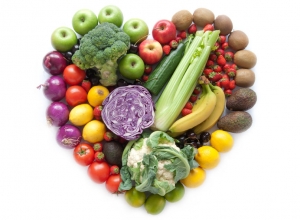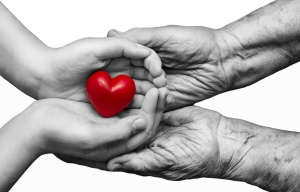
Laura Morse
I've recently learned having a plant in your office can improve your life dramatically. Plants are great for decoration, removing air pollutants and helping reduce stress!
Check out this infographic with details on some easy to maintain office plants and steps to keep them healthy!

Featured photo credit: Quill.com
In June we are spreading awareness for conserving the environment! In America, we often use many resources without thinking about the consequences. Although our country makes up less than 5 percent of the world population, we still consume over 30 percent of its resources. Also, 110 million Americans live with such high levels of air pollution that threaten their lives.
This is why it is so important that we spread awareness about the environment. Not only is the health of our planet in danger, but also our own health. Not many people are considering the impact that their actions are having on their planet and their neighbors.
This is why the Alpha Group will be hosting a Tree Planting event right here at Alpha Place! This is open to all clients, field employees, in-house employees, and the friends and families of everyone! Come join us with your shovels and garden gloves! We will be announcing the date later in the month.
There are so many things that you can change in your everyday life that will help save the environment. Even companies can make changes to their routines that are green. For a list of ways to go green and make an impact at your place of work, take a look at our list of ideas attached.
May is nationally known as ALS Awareness Month! ALS stands for amyotrophic lateral sclerosis, which is a motor neuron disease that affects a person’s ability to walk, dress, speak, swallow, and eventually breathe. About 6,000 people in the United States are diagnosed with ALS every year, yet there is no known cause or cure.
ALS is also commonly known as Lou Gehrig’s disease, which refers to the Yankee’s first baseman who passed away from the disease in 1941 at just 37 years old. Although there have been significant advances in research and treatment, there is still much more to learn about ALS.
ALS Awareness Month seeks to spread awareness, and encourages donations to support research, assist with family services, and provide financial support to individuals with ALS.
The Alpha Group will be accepting donations to benefit the Massachusetts Chapter of the ALS Association, and will also be participating in the Boston Walk to Defeat ALS in October. We will be joining Team Ienello, led by our Accounting & Payroll Coordinator, Hayley, whose father lost his battle with ALS in 2014.
We will be providing additional information as the Walk approaches, and if you are interested in joining or donating to Team Ienello please visit the team page!
April is Autism Awareness Month! Autism is a developmental disability that derives from an abnormality in the brain. It affects about 1 in every 68 births. It is characterized by difficulties with social and communication skills, repetition of behaviors, and resistance to major or minor changes in routine. Its full name is Autism Spectrum Disorder (ASD), which implies that some cases are more serious than others.
Although there is no cure for Autism, early intervention with children that do have Autism is vital to give them better brain function, communication skills, and social behaviors. The earlier it is detected, the more help a child can get. That is why it is very important to spread awareness about Autism Spectrum Disorder!
The Alpha Group is looking to help spread this awareness by holding a fundraiser. This will help raise funds toward public awareness, safety, family crisis assistance, job training, housing and research. Please feel free to stop by our office to make a small donation towards Autism Awareness.
Your Change Makes a Difference!
To Keep the Weight Off, Keep Tracking Your Diet
NEW ORLEANS — Keeping track of the foods you eat is an important strategy for weight loss, but continuing to monitor what you eat is also important to prevent regaining that weight. Now, a new study finds that stopping food tracking is linked to regaining weight.
In order to prevent re-gaining weight, people should make an effort four months after starting a diet to refocus on food tracking, according to the study, presented here Sunday (Nov. 13) at the American Heart Association's annual meeting called the Scientific Sessions.
The researchers found that people tended to stop dietary monitoring after about four months, and that this was followed by regaining weight, said Qianheng Ma, a public health researcher at the University of Pittsburgh and the lead author of the study.
The effects of food tracking, or "dietary self-monitoring," on weight loss have been well-studied, and the technique is a key component of what researchers call the "standard behavioral treatment" for people who want to lose weight and keep it off, Ma told Live Science. This type of treatment is the most effective non-medical approach to weight loss, according to the study.
In the study, the researchers looked at data from 137 people who had participated in a one-year weight loss intervention called EMPOWER. The majority of the people in the study were white women. The participants were, on average, 51 years old and had a BMI of 34.1. (People with a BMI of 30 or higher are generally considered obese.) The people in the study were asked to weigh themselves regularly with a digital scale that uploaded data in real time and to monitor their diet using a smartphone app.
Although everyone in the study initially lost weight, nearly three-quarters of the people in the study ultimately regained some of that weight. In addition, 62 percent of the participants stopped tracking what they were eating at some point during the study.
The researchers found that a greater percentage of the people who regained weight had stopped tracking what they ate, compared with those who were able to maintain their weight.
The average time that people tracked their diet before they stopped was 126 days — in other words, they were about four months into their diet when they stopped, Ma told Live Science. It's unclear why food tracking stopped at this point, she added.
People did not begin gaining weight immediately after they stopped tracking what they ate, the researchers noted. Rather, people started to gain weight, on average, about two months after they stopped tracking their food, the study found.
Now that the researchers have identified the point at which people tend to stop tracking their food, they intend to study whether strategically reminding people to keep tracking will help them to keep the weight off, Ma said.
The new findings have not been published in a peer-reviewed journal.
Originally published on Live Science.
http://www.livescience.com/56852-dietary-self-monitoring-weight-maintenance.html
Good vs. Bad Carbohydrates
Carbohydrates are an important part of your diet, but that doesn't mean you're free to load up on cakes and cookies to get your daily amount. Here, we explain the difference between good and bad carbohydrates.
By Diana Rodriguez
Medically Reviewed by Lindsey Marcellin, MD, MPH
Carbohydrates are an important part of a healthy diet, but there's much discussion about the good and bad carbohydrates.
So how do you know which is which? The answer is both simple — and complex.
Good vs. Bad Carbohydrates
Carbohydrates, often referred to as “carbs,” are your body's primary energy source, and they're a crucial part of any healthy diet. Carbs should never be avoided, but it is important to understand that not all carbs are alike.
Carbohydrates can be either simple (nicknamed "bad") or complex (nicknamed "good") based on their chemical makeup and what your body does with them.
Complex carbohydrates, like whole grains and legumes, contain longer chains of sugar molecules; these usually take more time for the body to break down and use. This, in turn, provides you with a more even amount of energy, according to Sandra Meyerowitz, MPH, RD, a nutritionist and owner of Nutrition Works in Louisville, Ky.
Simple carbohydrates are composed of simple-to-digest, basic sugars with little real value for your body. The higher in sugar and lower in fiber, the worse the carbohydrate is for you — remember those leading indicators when trying to figure out if a carbohydrate is good or bad.
Fruits and vegetables are actually simple carbohydrates — still composed of basic sugars, although they are drastically different from other foods in the category, like cookies and cakes. The fiber in fruits and vegetables changes the way that the body processes their sugars and slows down their digestion, making them a bit more like complex carbohydrates.
Simple carbohydrates to limit in your diet include:
Soda
Candy
Artificial syrups
Sugar
White rice, white bread, and white pasta
Potatoes (which are technically a complex carb, but act more like simple carbs in the body)
Pastries and desserts
Meyerowitz says that you can enjoy simple carbohydrates on occasion, you just don't want them to be your primary sources of carbs. And within the simple carb category, there are better choices — a baked potato, white rice, and regular pasta — than others — chips, cakes, pies, and cookies.
The Detail on Complex Carbohydrates
Complex carbohydrates are considered "good" because of the longer series of sugars that make them up and take the body more time to break down. They generally have a lower glycemic load, which means that you will get lower amounts of sugars released at a more consistent rate — instead of peaks and valleys —to keep you going throughout the day.
Picking complex carbohydrates over simple carbohydrates is a matter of making some simple substitutions when it comes to your meals. "Have brown rice instead of white rice, have whole-wheat pasta instead of plain white pasta," says Meyerowitz.
To know if a packaged food is made of simple or complex carbohydrates, look at the label. "Read the box so you know what exactly you're getting. If the first ingredient is whole-wheat flour or whole-oat flower, it's likely going to be a complex carbohydrate,” says Meyerowitz. "And if there's fiber there, it's probably more complex in nature."
The Glycemic Load Factor
Describing carbs as being either simple or complex is one way to classify them, but nutritionists and dietitians now use another concept to guide people in making decisions about the carbs they choose to eat.
The glycemic index of a food basically tells you how quickly and how high your blood sugar will rise after eating the carbohydrate contained in that food, as compared to eating pure sugar. Lower glycemic index foods are healthier for your body, and you will tend to feel full longer after eating them. Most, but not all, complex carbs fall into the low glycemic index category.
It is easy to find lists of food classified by their glycemic index. You can see the difference between the glycemic index of some simple and complex carbohydrates in these examples:
White rice, 64
Brown rice, 55
White spaghetti, 44
Whole wheat spaghetti, 37
Corn flakes, 81
100 percent bran (whole grain) cereal, 38
To take this approach one step farther, you want to look at the glycemic load of a food. The glycemic load takes into account not only its glycemic index, but also the amount of carbohydrate in the food. A food can contain carbs that have a high glycemic index, but if there is only a tiny amount of that carb in the food, it won’t really have much of an impact. An example of a food with a high glycemic index but a low glycemic load is watermelon, which of course tastes sweet, but is mostly water.
The bottom line: Just be sensible about the carbs you choose. Skip low-nutrient dessert, consider the levels of sugar and fiber in carbs, and focus on healthy whole grains, fruits, and veggies to get the energy your body needs every day.
Originally Published by:
http://www.everydayhealth.com/
By Diana Rodriguez
Medically Reviewed by Lindsey Marcellin, MD, MPH
Why Fruits and Vegetables Are Vital
Eating a diet rich in fruits and vegetables is important for good health. Find out why experts say Mother Nature's bounty packs better nutrients than supplements.
If we are what we eat, then many of us must be tripping all over the place due to a lack of balance. That's because the average American eats about three servings of fruits and vegetables per day — a stark contrast to the Department of Health and Human Services (HHS) and the U.S. Department of Agriculture's (USDA) new guidelines stating that we should be eating 5 to 13 servings of nature's best, depending on the number of calories you need.
So if we want to grow to be strong like Popeye, why can't we just down some supplements instead of devouring a pile of spinach?
Nutrients in fresh fruits and vegetables work together. Kristine Wallerius Cuthrell, MPH, RD, a research nutritionist and senior project coordinator for Hawaii Foods at the Center on the Family at University of Hawaii at Manoa, says that in the past five to 10 years, many large research studies have found that vitamin supplements don't provide the benefits that foods do. The 2005 Dietary Guidelines for Americans, created jointly between HHS and USDA and reviewed every five years, say that foods are the best sources of nutrients because they contain naturally occurring ingredients, like carotenoids and flavonoids.
"In addition to the substances we are aware of, there are many present in fruits and vegetables that have yet to be discovered. Food and the nutrients they contain aren't consumed singly, but with each other. As such, they may act in synergistic ways to promote health," Cuthrell says. For instance, eating iron-rich plants, like spinach, with an iron-absorbing enhancer, like the vitamin C in orange juice, is great for people who don’t get enough iron (typically young women).
Fruits and vegetables may prevent many illnesses. Eating fruits and vegetables may reduce your risk of cardiovascular diseases, stroke, type 2 diabetes, and even some forms of cancer. The Nurses' Health Study and Health Professionals Follow-up Study examined nearly 110,000 people over the course of 14 years. Part of the study revealed that the more fruits and vegetables people ate daily, the less chance they would develop cardiovascular diseases.
The relationship between fruits and vegetables and cancer prevention has been more difficult to prove. However, recent studies show that some types of produce are associated with lower rates of some types of cancer. For example, the World Cancer Research Fund and the American Institute for Cancer Research suggest that mouth, stomach, and colorectal cancers are less likely with high intakes of non-starchy foods like leafy greens, broccoli, and cabbage. Though studies have been mixed, lycopene, a carotenoid that gives tomatoes their red color, may help stave off prostate cancer.
Fruits and vegetables are great for watching your weight. They’re low in fat and calories, and loaded with fiber and water, which create a feeling of fullness. This is particularly helpful for dieters who want more filling calories. Plus, that fiber helps keep you “regular.”
Fruits and Vegetables: Get Your Fill
When adding fruits and vegetables to your diet, remember that variety is the spice of life. It's important to eat produce of various colors because each fruit or vegetable offers a different nutrient — think of it as nutritional cross-training. Trying new foods can be exciting, and be sure to sample every color in the produce rainbow.
The right number of servings of fruits and vegetables for you all depends on your daily caloric intake needs. A good way to find out how many servings you should be eating is by using the CDC's online serving calculator. Or make things even simpler by eating a fruit or vegetable at every meal and snack.
Don't let season, accessibility, or cost affect your fruit- and vegetable-friendly diet. If finding fresh produce is difficult, choose frozen, canned (low-sodium), or dried varieties. Also, 100 percent juice counts toward your servings, though it doesn't offer the full fiber of whole fruit.
The power of prevention may lie in a salad bowl or a plate of fruit. When we take advantage of produce, our bodies return the favor by reducing our risk of developing various illnesses.
Originally Published by: Everydayhealth.com By Melanie Winderlich Medically Reviewed by Pat F. Bass, III, MD, MPH
http://www.everydayhealth.com/diet-nutrition/101/nutrition-basics/fruits-and-vegetables.aspx
March Is…
National Nutrition Month
March is National Nutrition Month! This month we will be reviewing what food we put into our bodies and considering better and healthier options.
Americans typically exceed the recommended daily portions for calories from solid fats and added sugars, refined grains, sodium, and saturated fats and yet do not get enough of vegetables, fruits, whole-grains, dairy products, and oils.
During the month of March, let’s look at our diet and nutrition and see where we can improve. Studies have shown that keeping track of your eating throughout the day for extended periods of time can help people cut down on their eating. Many people have food journals or use Smartphone applications such as My Fitness Pal that keep track of eating, drinking, and exercise habits.
The Alpha Group will also be holding a month-long food drive in the lobby of Alpha Place. These donations will be benefiting the Hebron Food Pantry in Attleboro. Feel free to leave a donation of healthy non-perishable items in the box in the lobby. Also, feel free to donate directly to the Hebron Food Pantry at their location or online http://www.hebronfoodpantry.org/
Smartphones Could Be a Boon to Heart Health Research
Smartphones might revolutionize cardiac research by giving instant, accurate insight into the physical activity of people using them, a new study finds.
"People check these devices [an average of] 46 times a day," noted study senior author Dr. Euan Ashley, an associate professor of cardiovascular medicine at Stanford University in Palo Alto, Calif.
"From a cardiovascular health standpoint, we can use that personal attachment to measure physical activity, heart rate and more," he said in a university news release.
In the study, Ashley's team enlisted subjects via a free iPhone app called MyHeart Counts.
The researchers enrolled more than 47,000 Americans across all 50 states, and were able to track data about the physical activity of nearly 5,000 participants who took a six-minute walking fitness test.
"The ultimate goals of the MyHeart Counts study are to provide real-world evidence of both the physical activity patterns most beneficial to people and the most effective behavioral motivation approaches to promote healthy activity," said study co-lead author Dr. Michael McConnell. He's a professor of cardiovascular medicine at Stanford.
Why is it beneficial to get numbers from a smartphone? Because people often overestimate how much they exercise when they are simply asked in a survey, the researchers said.
"Traditional research on physical activity and cardiovascular health has been based on people writing down what they remembered doing," McConnell said. "Mobile devices let us measure more directly people's activity patterns throughout the day."
The researchers found that people who were active throughout the day, and not just once for a fairly short session, were healthier on the cardiac front. And those who mostly exercised on the weekend and went to bed early tended to be healthier.
One heart specialist who reviewed the new study believes the smartphone initiative has merit.
"It helps health care providers and patients alike in monitoring physical activity, setting goals, and achieving desired results," said Dr. Satjit Bhusri, a cardiologist at Lenox Hill Hospital in New York City. "As a result, we have up-to-date information on our patients' progress and prevention of heart disease."
Dr. Stacey Rosen is vice president of Northwell Health's Katz Institute for Women's Health in New Hyde Park, N.Y. She believes that tracking people via a smartphone could greatly expand research opportunities.
Right now, she said, "there are challenges to large-scale research initiatives -- cost, staffing and recruitment and retention of subjects."
"Enhancing the ability of the almost ubiquitous smartphone, to help us better understand ways to modify behavior that impact positively on heart disease risk, is a major game-changer," Rosen said.
The study was published Dec. 14 in JAMA Cardiology. There's more on keeping your heart healthy at the American Heart Association.
SOURCES: Satjit Bhusri, M.D., cardiologist, Lenox Hill Hospital, New York City; Stacey Rosen, M.D., vice president, women's health, Northwell Health's Katz Institute for Women's Health, New Hyde Park, N.Y.; Stanford University, press release, Dec. 14, 2016; JAMA Cardiology, Dec. 14, 2016
Originally published by: consumer.healthday.com
Don’t wait to get help if you experience any of these heart attack warning signs. Although some heart attacks are sudden and intense, most start slowly, with mild pain or discomfort. Pay attention to your body — and call 911 if you feel:
- Chest discomfort. Most heart attacks involve discomfort in the center of the chest that lasts more than a few minutes, or that goes away and comes back. It can feel like uncomfortable pressure, squeezing, fullness or pain.
- Discomfort in other areas of the upper body. Symptoms can include pain or discomfort in one or both arms, the back, neck, jaw or stomach.
- Shortness of breath with or without chest discomfort.
- Other signs may include breaking out in a cold sweat, nausea or lightheadedness.
Download our heart attack warning signs infographic.
Symptoms Vary Between Men and Women
As with men, women's most common heart attack symptom is chest pain or discomfort. But women are somewhat more likely than men to experience some of the other common symptoms, particularly shortness of breath, nausea/vomiting, and back or jaw pain. Learn about the warning signs of heart attack in women.
Act Fast
Learn the signs, but remember this: Even if you're not sure it's a heart attack, have it checked out. Minutes matter! Fast action can save lives — maybe your own. Don't wait - call 911 or your emergency response number.
Call 911
Calling 911 is almost always the fastest way to get lifesaving treatment. Emergency medical services (EMS) staff can begin treatment when they arrive — up to an hour sooner than if someone gets to the hospital by car. EMS staff are also trained to revive someone whose heart has stopped. Patients with chest pain who arrive by ambulance usually receive faster treatment at the hospital, too. It is best to call EMS for rapid transport to the emergency room.
Orginally published by: http://www.heart.org/
By making these 10 lifestyle changes, you can lower your blood pressure and reduce your risk of heart disease.
If you've been diagnosed with high blood pressure, you might be worried about taking medication to bring your numbers down.
Lifestyle plays an important role in treating your high blood pressure. If you successfully control your blood pressure with a healthy lifestyle, you might avoid, delay or reduce the need for medication.
Here are 10 lifestyle changes you can make to lower your blood pressure and keep it down.
1. Lose extra pounds and watch your waistline
Blood pressure often increases as weight increases. Being overweight also can cause disrupted breathing while you sleep (sleep apnea), which further raises your blood pressure.
Weight loss is one of the most effective lifestyle changes for controlling blood pressure. Losing just 10 pounds (4.5 kilograms) can help reduce your blood pressure.
Besides shedding pounds, you generally should also keep an eye on your waistline. Carrying too much weight around your waist can put you at greater risk of high blood pressure.
In general:
- Men are at risk if their waist measurement is greater than 40 inches (102 centimeters).
- Women are at risk if their waist measurement is greater than 35 inches (89 centimeters).
These numbers vary among ethnic groups. Ask your doctor about a healthy waist measurement for you.
2. Exercise regularly
Regular physical activity — at least 30 minutes most days of the week — can lower your blood pressure by 4 to 9 millimeters of mercury (mm Hg). It's important to be consistent because if you stop exercising, your blood pressure can rise again.
If you have slightly high blood pressure (prehypertension), exercise can help you avoid developing full-blown hypertension. If you already have hypertension, regular physical activity can bring your blood pressure down to safer levels.
The best types of exercise for lowering blood pressure include walking, jogging, cycling, swimming or dancing. Strength training also can help reduce blood pressure. Talk to your doctor about developing an exercise program.
3. Eat a healthy diet
Eating a diet that is rich in whole grains, fruits, vegetables and low-fat dairy products and skimps on saturated fat and cholesterol can lower your blood pressure by up to 14 mm Hg. This eating plan is known as the Dietary Approaches to Stop Hypertension (DASH) diet.
It isn't easy to change your eating habits, but with these tips, you can adopt a healthy diet:
- Keep a food diary. Writing down what you eat, even for just a week, can shed surprising light on your true eating habits. Monitor what you eat, how much, when and why.
- Consider boosting potassium. Potassium can lessen the effects of sodium on blood pressure. The best source of potassium is food, such as fruits and vegetables, rather than supplements. Talk to your doctor about the potassium level that's best for you.
- Be a smart shopper. Read food labels when you shop and stick to your healthy-eating plan when you're dining out, too.
4. Reduce sodium in your diet
Even a small reduction in the sodium in your diet can reduce blood pressure by 2 to 8 mm Hg.
The effect of sodium intake on blood pressure varies among groups of people. In general, limit sodium to less than 2,300 milligrams (mg) a day or less. However, a lower sodium intake — 1,500 mg a day or less — is appropriate for people with greater salt sensitivity, including:
- African-Americans
- Anyone age 51 or older
- Anyone diagnosed with high blood pressure, diabetes or chronic kidney disease
To decrease sodium in your diet, consider these tips:
- Read food labels. If possible, choose low-sodium alternatives of the foods and beverages you normally buy.
- Eat fewer processed foods. Only a small amount of sodium occurs naturally in foods. Most sodium is added during processing.
- Don't add salt. Just 1 level teaspoon of salt has 2,300 mg of sodium. Use herbs or spices to add flavor to your food.
- Ease into it. If you don't feel you can drastically reduce the sodium in your diet suddenly, cut back gradually. Your palate will adjust over time.
5. Limit the amount of alcohol you drink
Alcohol can be both good and bad for your health. In small amounts, it can potentially lower your blood pressure by 2 to 4 mm Hg.
But that protective effect is lost if you drink too much alcohol — generally more than one drink a day for women and for men older than age 65, or more than two a day for men age 65 and younger. One drink equals 12 ounces of beer, five ounces of wine or 1.5 ounces of 80-proof liquor.
Drinking more than moderate amounts of alcohol can actually raise blood pressure by several points. It can also reduce the effectiveness of blood pressure medications.
6. Quit smoking
Each cigarette you smoke increases your blood pressure for many minutes after you finish. Quitting smoking helps your blood pressure return to normal. People who quit smoking, regardless of age, have substantial increases in life expectancy.
7. Cut back on caffeine
The role caffeine plays in blood pressure is still debated. Caffeine can raise blood pressure by as much as 10 mm Hg in people who rarely consume it, but there is little to no strong effect on blood pressure in habitual coffee drinkers.
Although the effects of chronic caffeine ingestion on blood pressure aren't clear, the possibility of a slight increase in blood pressure exists.
To see if caffeine raises your blood pressure, check your pressure within 30 minutes of drinking a caffeinated beverage. If your blood pressure increases by 5 to 10 mm Hg, you may be sensitive to the blood pressure raising effects of caffeine. Talk to your doctor about the effects of caffeine on your blood pressure.
8. Reduce your stress
Chronic stress is an important contributor to high blood pressure. Occasional stress also can contribute to high blood pressure if you react to stress by eating unhealthy food, drinking alcohol or smoking.
Take some time to think about what causes you to feel stressed, such as work, family, finances or illness. Once you know what's causing your stress, consider how you can eliminate or reduce stress.
If you can't eliminate all of your stressors, you can at least cope with them in a healthier way. Try to:
- Change your expectations. Give yourself time to get things done. Learn to say no and to live within manageable limits. Try to learn to accept things you can't change.
- Think about problems under your control and make a plan to solve them. You could talk to your boss about difficulties at work or to family members about problems at home.
- Know your stress triggers. Avoid whatever triggers you can. For example, spend less time with people who bother you or avoid driving in rush-hour traffic.
- Make time to relax and to do activities you enjoy. Take 15 to 20 minutes a day to sit quietly and breathe deeply. Try to intentionally enjoy what you do rather than hurrying through your "relaxing activities" at a stressful pace.
- Practice gratitude. Expressing gratitude to others can help reduce stressful thoughts.
9. Monitor your blood pressure at home and see your doctor regularly
Home monitoring can help you keep tabs on your blood pressure, make certain your lifestyle changes are working, and alert you and your doctor to potential health complications. Blood pressure monitors are available widely and without a prescription. Talk to your doctor about home monitoring before you get started.
Regular visits with your doctor are also key to controlling your blood pressure. If your blood pressure is under control, you might need to visit your doctor only every six to 12 months, depending on other conditions you might have. If your blood pressure isn't well-controlled, your doctor will likely want to see you more frequently.
10. Get support
Supportive family and friends can help improve your health. They may encourage you to take care of yourself, drive you to the doctor's office or embark on an exercise program with you to keep your blood pressure low.
If you find you need support beyond your family and friends, consider joining a support group. This may put you in touch with people who can give you an emotional or morale boost and who can offer practical tips to cope with your condition.
Originally Published by: Mayo Clinic Staff
Join us during American Heart Health Month as we put in time and effort to care for our hearts. Follow the Heart Truth’s “28-Days to a Healthy Heart” Challenge yourself every day of the month of February to do more for your heart! When we make an effort to care for our heart, we will definitely reap the benefits.
February Is…
American Hearth Health Month
February is American Heart Health Month! The heart needs a lot of help in order to stay strong and healthy, but it’s easy for you to make some daily changes that will keep your heart ticking! Heart disease is the leading cause of death among both men and women. Also one in every three adults in the United States has high blood pressure, which not only can damage your heart, but also your arteries, brain, and kidneys.
Join us during American Heart Health Month as we put in time and effort to care for our hearts. Follow the Heart Truth’s “28-Days to a Healthy Heart” Challenge yourself every day of the month of February to do more for your heart! When we make an effort to care for our heart, we will definitely reap the benefits.
Please take the time to learn more about what you can do for your heart! Feel free to visit a Walgreens or CVS Pharmacy in order to receive a free blood pressure screening. Learn your numbers so you can get your healthy heart back!!
Lives You Save: Patient Stories
Your Gift...Their Life: How Patients Benefit
Every time you donate blood you help save a life. Sounds extreme?
Not to the patients whose lives have been saved through the efforts of our donors.
Brandon Levine
On January 30, 2015 Brandon received the rare opportunity to meet with 40 of the people who helped saved his life through blood donations. Brandon nearly died in a motorcycle accident on April 27th and in efforts to save him received over 200 units of blood products. During the event, Brandon was able to share his story with the donors that helped save his life and personally thank them by saying "...a part of you is inside of me and that's why I'm standing here today." Read the full story »
Related Links: UCLA Health | CBS Los Angeles | Yahoo! News |U.S. News & World Report | Daily Mail
Jennifer Calderon
Due to confidentiality laws, most blood donors never know who receives their blood. Similarly, patients never learn the identities of those who donated their time and blood to save their lives. But a rare reunion organized by the UCLA Blood and Platelet Center changed that. A young mother who nearly died from massive bleeding after giving birth to her premature son was able to meet seven blood and platelet donors who sustained her life with their generous donations.
Jennifer C. expressed her gratitude for the 24 units of donated blood, plasma and platelets that preserved her life — and allowed her sons to have their mother. Jennifer suffered uterine hemorrhaging after a high-risk cesarean section at Ronald Reagan UCLA Medical Center in April 2013. Only 5-feet tall, she lost five liters of blood — nearly her entire supply — and was hospitalized at UCLA for two weeks, with two days in intensive care.
Related Links: CBS Los Angeles, NBC Southern California, KTLA 5, UCLA Health, KHTS AM 1220, KCAL News

Jennifer Golden
Twenty-one year old college student Jennifer Golden from Las Vegas, Nevada received 24 units of blood products during her double lung and liver transplant surgery. Jennifer was diagnosed at 5 months old with cystic fibrosis, which affected her lungs and deteriorated her liver. At the time Jennifer received the transplant, her lung capacity was at 12% and she was constantly coughing and having to catch her breath. The 13 hour surgery performed at the UCLA Ronald Reagan Medical Center in 2011 was a success. During an interview, Jennifer was asked what she planned to do in the future and she answered "...I never really got a chance to think about what I wanted to do. It was always day by day. Now I can think about a future."

John-Paul Quintero
"Because of a rare form of anemia that my 3 year old son has, he needs blood transfusions every two to three weeks in order to survive.
So I urge you... make that call, make the time and donate blood. It doesn't cost a thing and it's worth more than all the money in the world - It's the gift of life and you can give it."
– Marisol Quintero
John's Mother
 Alyssa Gomez
Alyssa Gomez
"You don't know how important donating blood is until you're sick." That's what Alyssa Gomez tells people and she knows it's true. In the fall of 2004, Alyssa was diagnosed with leukemia and her treatment requires that she receive both whole blood and platelets. Thanks to everyone who donated at the UCLA blood drive for Alyssa at Canterbury Elementary School and, thanks to many UCLA Blood & Platelet Center donors, Alyssa is getting the treatment she needs.
"We're proud to be a part of Alyssa's team, helping provide community support so that Alyssa, with her amazing attitude and big smile, will be able to do all the things a 9th grader wants to do: dance, act, model and enjoy the company of her good friends and loving family. You became part of Alyssa's Team, a team that included doctors, nurses, family and friends and now you!"
Gary Livitski
 "When the third of my three consecutive bone marrow transplants worked, I didn't know who was happier, me or the nearly 80 people who came into the UCLA Blood & Platelet Center and donated blood and platelets for me. Almost daily, for the entire three months that I was a patient at UCLA my friends, my family, and/or my fellow officers from the Beverly Hills Police Department came into the donor center to donate. Without fail, their experiences were fantastic.
"When the third of my three consecutive bone marrow transplants worked, I didn't know who was happier, me or the nearly 80 people who came into the UCLA Blood & Platelet Center and donated blood and platelets for me. Almost daily, for the entire three months that I was a patient at UCLA my friends, my family, and/or my fellow officers from the Beverly Hills Police Department came into the donor center to donate. Without fail, their experiences were fantastic.
Their time constraints were accommodated and any scheduling issues were handled. Even today, 4 years later, many of them still donate; and they do because they believe it's just the right thing to do. When people talk about donating as giving The Gift of Life they mean it. The more than 184 units of blood, platelets, and plasma I received helped save mine."
– Gary Livitski
Lauren Larsen
Lauren Larsen became a multi-gallon blood recipient during the near-fatal birth of her only child. Several of her actual blood donors talk about what it was like to meet Lauren-and her family-in person four years after helping to save her life. This narrative underscores the direct connection between blood donors and the people whose lives they impact. This blood donation advocacy video was produced by In The Telling with educational funding from Johnson & Johnson.
Originally posted by: http://gotblood.ucla.edu/the-lives-you-save
The Mystery of Human Blood Types
The ABO blood group evolved at least 20 million years ago, but scientists still don't understand the purpose of blood types
Donate Blood
Blood Facts
- Today, fewer than 4 of every 10 people in the U.S. are eligible to give blood. Fewer than 1 in 10 actually donate.
- Approximately 40,000 pints of blood are used each day in the United States.
- Approximately 1 out of every 7 people entering the hospital needs blood.
- 1 donation has the potential to save as many as 3 lives.
- 3 teaspoons of blood can save a baby's life.
- If there are 100 people in a room, 46 will have type O blood, 40 will have type A, 10 will have type B and four will have type AB.
- If 50 people donate, they could provide enough blood to take care of victims of a major car accident.
- If 20 people donate, they could help 1 burn victim.
- Most whole blood donors can give every 8 weeks.
- Plasma donors can give as often as every 3 days.
- Blood lasts only 42 days.
- Platelets last only 5 days.
See the link below for more details!
http://www.bloodsource.org/Donate/Blood-Facts-FAQs
Originally posted by Blood Source
January Is…
National Blood Donor Month
Happy New Year! With the closing of another year, we will jump right into our second month of Alpha Cares, which raises awareness and funds for causes that are near and dear to our hearts!
January is National Blood Donor Month! Every two seconds, someone in the United States needs blood. Those who suffer from accidents or sickness are in great need for red blood cells, plasma, platelets, and cryoprecipitate that come from donated blood.
Many people have a fear of blood or needles that keep them away from donating blood. However those with that fear who decide to give blood find that the process is easy, relatively pain-free, and quick. The donation process is quite simple, as it is split into four parts: registrations, health history and mini-physical, donation, and refreshments.
You too can save a life by donating blood. Visit www.redcross.org and type in your zip code to find the nearest blood drive location. Please consider supporting this important cause, as there are many people who are in need of donated blood every minute.

The Alpha Group is excited to introduce Alpha Cares!
This December The Alpha Group will kick off our year-long Alpha Cares Campaign, which raises awareness and funds for a variety of causes near and dear to our hearts. Our team will be planning numerous events throughout the year to not only shed light on all of these causes, but also help promote participation within our community.
Throughout the month various resources will be available with facts and statistics on that month’s focus, as well as ways to aid in prevention and treatment.
To do this, however, we will need your help!
December is International Safe Toys and Gifts Awareness Month. Come join us as we get into the holiday giving season! We will be holding a Toys for Tots drive November 28th - December 14th, and are calling for donations of new, unwrapped toys. The toys can be dropped off in the lobby our Norton office, all of which will then be donated to Toys for Tots.
If you would like to hear more about donating to Toys for Tots, or learn about our upcoming Alpha Cares Campaign programs please feel free to contact us!
Stay tuned for more details on upcoming months of Alpha Cares!
Here is a list of the other upcoming months and causes:
January National Blood Donor Month
February American Heart Health Month
March National Nutrition Month
April National Autism Awareness Month
May ALS Awareness Month
June Environmental Awareness
July UV Safety Month – Skin Cancer Awareness
August Animal Health Month
September Childhood Cancer Awareness
October Breast Cancer Awareness Month
November Diabetes Awareness Month












